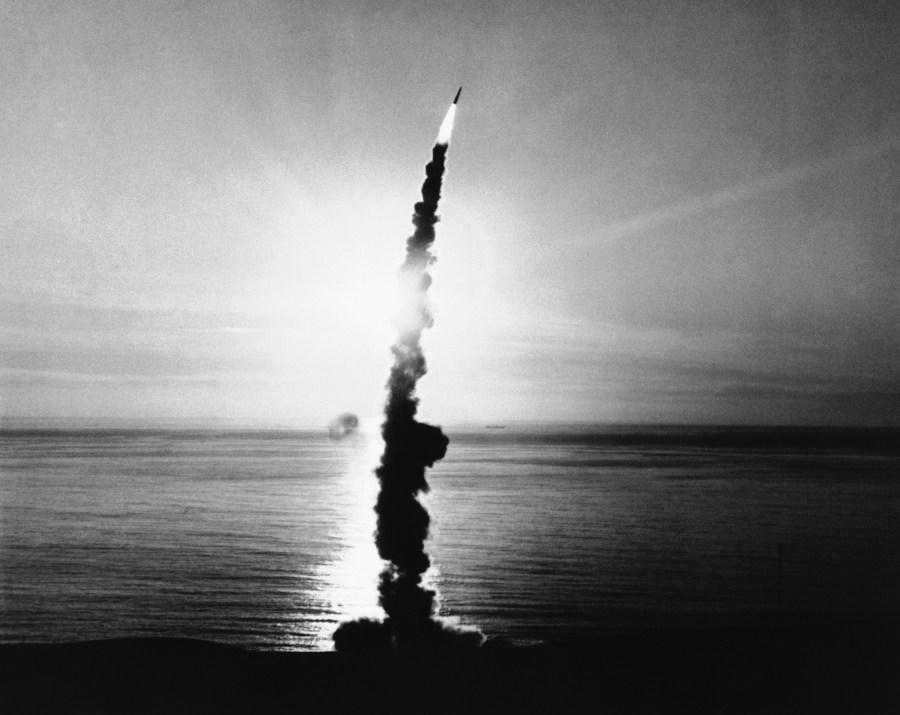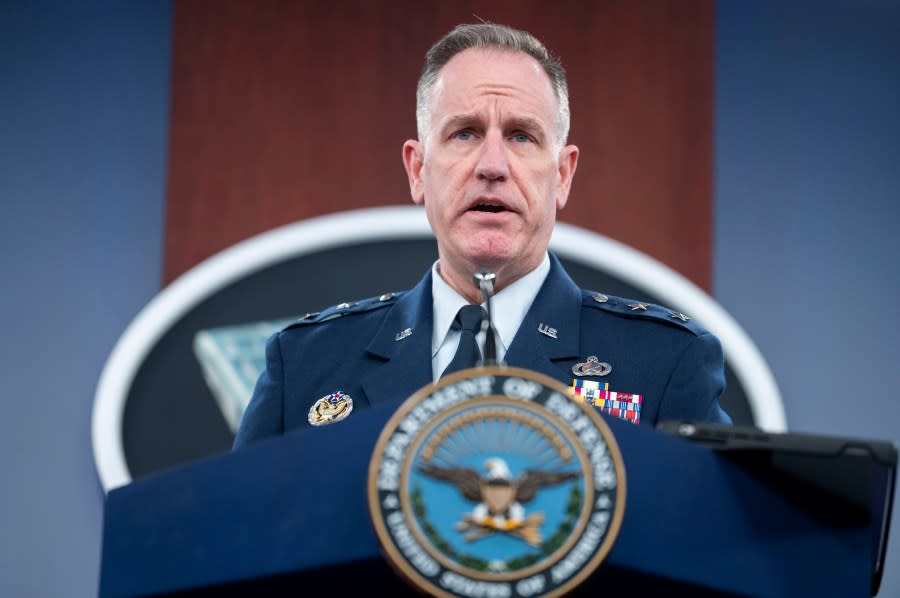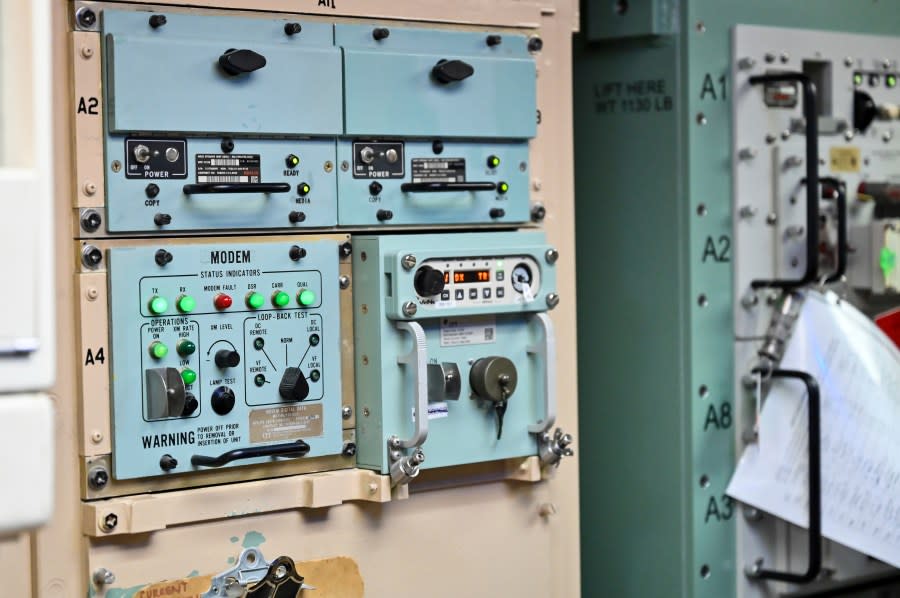Skyrocketing cost of US nuclear missile program spurs reckoning

- Oops!Something went wrong.Please try again later.
This is the first story in a series about Sentinel, the Air Force’s nuclear missile modernization project. Other stories will touch on how the project is impacting local communities and tension over plutonium pit production for the new missiles.
In the last years of the Obama administration, a debate rippled across Washington. The U.S. could continue life-extending the Minuteman III intercontinental ballistic missile (ICBM), which at the time had been deployed for close to 50 years, or modernize the system in a major overhaul.
Facing pressure from lawmakers, then-President Obama in 2016 elected to modernize the entire nuclear triad: land-based ICBMs, submarines and bomber planes.
While the estimated trillion-dollar price tag drew headlines, the actual cost of the unprecedented effort could far exceed that amount, given the ICBM modernization — now called Sentinel — continues driving up costs.
The latest alarm rang in January, when the Air Force overshot its projected budget by 37 percent, triggering a critical breach that requires the Pentagon to step in and review Sentinel.
Sentinel has reopened a debate in Congress and in the nuclear security world about the role and necessity of ICBMs, viewed as the most destabilizing part of the U.S. triad because they are easy targets, invite a devastating attack in the U.S. heartland and give the president only 30 minutes to respond in the event of an attack.
The Air Force insists there is no other option but to address the issues and keep moving with Sentinel, which is overseen by defense contractor Northrop Grumman, a company experiencing its own troubles with staffing and workforce requirements.
“Sentinel will be funded,” said Air Force Deputy Chief of Staff for Plans and Programs Lt. Gen. Rick Moore at a January Center for Strategic and International Studies event. “We’ll make the trades that it’s going to take to make that happen.”
But some members of Congress are increasingly frustrated over rising cost estimates and anxious to pump the brakes on the program.
“I’ve been angered by the Air Force’s [Sentinel] program,” said Rep. John Garamendi (D-Calif.), a House Armed Services member. “For more than 12 years now I’ve been following very closely and raising questions about fundamental issues that were either ignored or inadequately addressed.
“The estimates that were made over that period of time, from [around] 2012 to today, was simply woefully underestimated,” Garamendi added. “We’re at an important moment and opportunity to evaluate this extraordinarily important, expensive program.”
Since the cost of nuclear modernization was calculated, the land-based program cost has more than doubled since 2015 to over $130 billion. Several dramatic changes in projected costs have raised questions about how early estimates were concluded, given the program was selected in part so the U.S. could save money.
The program involves replacing or refurbishing the 400 deployed missiles, and their silos, launch centers and other integral parts, in the rural Western U.S., while also constructing new real estate across three Air Force bases and roughly 40,000 square miles of land.
The scramble to replace Minuteman by 2030 concerns some critics, who say the program’s costs could jeopardize spending for conventional U.S. forces.
“This will be the first time that the nation has tried to simultaneously modernize the nuclear enterprise while it’s trying to modernize an aging conventional enterprise,” said then-Air Force Chief of Staff Gen. Dave Goldfein in a 2020 event with the Brookings Institution.
“The current budget does not allow you to do both,” he said. “Either there are going to be significant trades made or we’re going to have to find a fund for strategic nuclear deterrence.”
From Minuteman to Sentinel

The first Minuteman III missiles were deployed in 1970, successors to those deployed throughout the 1960s.
Minuteman III was not intended to last longer than 10 years, let alone half a century. But the Air Force has continued to work with contractors to extend their life, along with their housing infrastructure, and they continue to perform well in tests, though the Pentagon claims they are nearing the end of their life cycle.
The 400 Minuteman missiles, which each weigh close to 80,000 pounds, remain today inside silos at F.E. Warren Air Force Base in Wyoming, Malmstrom Air Force Base in Montana and Minot Air Force Base in North Dakota, while there are silos in other rural Western states.
The first model of Minuteman cost about $17 billion, adjusted for inflation, according to Pentagon officials in 2017, who were hopeful Minuteman’s replacement would be in a similar ballpark.
Despite the refurbishments, replacing Minuteman was seen as inevitable, and modernizing was debated in Washington as far back as the early 1990s. But the project was delayed as the U.S. pursued the war against terrorism in the 2000s and early 2010s.
Congress first required the U.S. to pursue a 2030 nuclear modernization schedule in the 2007 National Defense Authorization Act (NDAA) — and that date remains the Sentinel missile deployment target.
But Obama began negotiating a nuclear treaty with Russia during his first term.
The talks concluded with the New START treaty in 2010, limiting both countries to 1,550 deployed nuclear warheads and 700 deployed ICBMs, submarines and bombers. The treaty has been suspended by Russia during the ongoing Ukraine war but lasts until 2026.
Congress required Obama to commit to modernizing the triad to win support for the treaty, something the president ultimately agreed to in 2016.
The Air Force began looking more seriously at a Ground-Based Strategic Deterrent (GBSD) system to replace Minuteman around 2013. The following year, Air Force officials released a report, called the Analysis of Alternatives, that determined Sentinel would be cheaper than life-extending Minuteman.
Sentinel’s $60 billion initial price tag in 2015 jumped to $85 billion the next year. After an initial study period and the awarding of development contracts, it bumped to more than $95 billion by 2020. The January breach includes a program acquisition unit cost increase from $118 million to $162 million, which means Sentinel is now at around $131 billion.
“A [cost] breach of this magnitude usually signals that a program is going to be terminated,” said Sharon Weiner, a visiting researcher from American University and a nuclear expert, during a January event with the Arms Control Association.
The Congressional Budget Office, which estimates the entire nuclear force cost every two years, has tracked a massive increase in projections for work on the triad over the years, jumping by roughly $100 billion each report since modernization was discussed more seriously in 2013.
In an updated report last year, the cost soared to $756 billion over the 2023-2032 period. The spikes have been driven largely by real estate and construction costs, according to Northrop Grumman and the Air Force.
The Hill requested a copy of the 2014 Analysis of Alternatives, which laid the foundation for approving GBSD, but the Air Force said it was classified. However, it said in a statement that the report identified a Minuteman replacement as the “most cost-effective option” for nuclear modernization.
GBSD was renamed to Sentinel in 2022. The goal is to purchase 650 nuclear missiles and deploy 400 of them through 2075.
Sentinel program under the microscope
Over the past two debates, lawmakers and outside groups have consistently questioned the size and scope of the Sentinel program, its necessity — and how the original cost estimates were reached.
In 2014, RAND Corporation, a Washington, D.C., think tank, reported that life-extending Minuteman would be cheaper, a “relatively inexpensive way” to maintain ICBMs.
Mackenzie Knight, a nuclear researcher with the Federation of American Scientists, questioned how the Air Force replacement determination was reached. She speculated the numbers were “pulled out of thin air” and possibly skewed to favor Sentinel with arbitrary requirements like keeping the new missiles deployed through 2075.
“It is clear that the Air Force and the Department of Defense wanted this program to happen,” she told The Hill. “They wanted this program to happen very badly.”
The Air Force did not respond to questions about why it selected 2075 as the date to keep the Sentinel missile in operation or how it determined its initial findings.
In 2020, some members of Congress called on the Air Force to allow a scientific advisory group to independently determine the cost of replacing Minuteman. A requirement was never put into law and the Air Force never worked with the group.
When asked if he would approve of an independent assessment, Gen. Anthony Cotton, head of U.S. Strategic Command, said in a February congressional hearing that he “agrees with the previous estimates” that were done to estimate the cost of Sentinel and argued it was a vital program.
“What I cannot endure as a combatant commander … is having a gap or a drop in the reliability in the current [triad] platform,” he said.
Sen. Elizabeth Warren (D-Mass.) scolded him at the hearing, saying there have been “bright, blinking warnings that this program was not on track.”
“I want to make sure that what we’re going to be replacing [Minuteman] with has been fully vetted and is the right direction for us,” she said. “We can’t just keep burning money.”
Warren said the Air Force has pursued an “aggressive schedule” relying on immature technology assessments.
In the NDAA passed at the end of last year, Congress inserted several amendments related to Sentinel, including regular congressional briefings on construction projects, a robust master schedule and a plan for fielding the weapon system.
But Congress remains generally united behind Sentinel and nuclear modernization, as it has for decades, and supporters argue any program of this magnitude would inevitably see a budget overblow.
Sens. Roger Wicker (R-Miss.), ranking member on the Senate Armed Services Committee, and Deb Fischer (R-Neb.), ranking member of the strategic forces subcommittee, also argued that “abandoning or downsizing Sentinel isn’t an option” in light of national security challenges against nuclear-armed adversaries like China and Russia.
The GOP senators conceded that Sentinel costs will continue rising “dramatically” as construction materials are purchased, but blamed the problems on the Biden administration.
“This administration, including the Pentagon, had ample opportunities to encourage innovation, demand program performance, and push for expanded domestic industrial capacity,” they said in a joint statement.
“Sentinel might have weathered such challenges if defense planners and the White House had handled them appropriately.”
Unprecedented size and scale

Sentinel will see the Air Force and primary contractor Northrop Grumman undertake a never-before-seen nuclear modernization project involving many parts.
The project is supposed to start construction within the next few years and field in 2029 or early 2030, but the Air Force said after the January breach that there would likely be a two-year delay in deployment.
Pentagon press secretary Maj. Gen. Pat Ryder said the Pentagon will “conduct a robust review” of the program in the coming months.
“We will, of course, engage closely with Congress and be as open as possible as this moves forward,” Ryder said in a January press briefing.
The main focus of Sentinel rests on the 400 deployed missiles, which will be newly constructed and fitted with revamped warheads hosting fresh plutonium shells. The second part of the project is refurbishing each of the 450 launch areas, including the underground silos and launch control centers.
Other work involves constructing close to 50 new support buildings, 62 communication towers and more than 7,500 miles of utility lines and corridors, part of a large real estate development component of Sentinel.
The challenges facing Sentinel broke into the public discussion in November, when Air Force Secretary Frank Kendall admitted the program was “struggling,” describing it as the “biggest thing” the Air Force has ever done.
The Air Force told The Hill that it has not seen a cost increase in fielding the missile itself, but that most of the price hike is related to real estate work that includes laying thousands of miles of fiber optic networks to replace old telephone lines and the acquisition of permanent and temporary land easements with hundreds of landowners.
Work began last year on surveys, real estate acquisitions, design investigations and construction at F.E. Warren in Wyoming, according to Air Force Global Strike Command. In addition to three Air Force bases, work will also be done at Utah’s Hill Air Force Base and Utah Test and Training Range, Camp Navajo, Ariz., and Camp Guernsey in Wyoming.
Critics question role of ICBMs in modern world

The U.S. has long considered all three legs of the triad as essential, but anti-nuclear groups say the argument for the land-based leg is the weakest and should be reevaluated, especially at the price for Sentinel.
The heart of the concerns are that ICBMs are inherently destabilizing and lack the tactical advantages of the sea and air parts of the triad.
America’s Ohio-class U.S. nuclear submarines, all 14 of which endlessly patrol the world’s oceans, are stealthy, evading adversaries. A U.S. nuclear bomber, such as the B-2 Spirit, is hard to hit and can also be recalled in the event it is sent out to strike a target. But the Minuteman missiles are sitting in the rural Western U.S. in plain sight.
A new Princeton University project has documented the impact of a potential nuclear strike on the ICBMs. The fallout would devastate much of the continent, decimating communities in the rural West.
The Biden administration’s 2022 Nuclear Posture Review identified ICBM modernization as a critical national security priority, as does a similar strategic posture review from Congress last fall.
The argument for ICBMs is they would exhaust an adversary’s resources, assuming a hostile nation would target them to wipe out U.S. response capabilities. Critics say it relies on dangerous assumptions, including that Russia would make the same calculations as America.
Anna Erickson, a nuclear science professor at the Georgia Institute of Technology, explained that ICBMs are primed for firing and are faster than bombers and submarines.
“From a neutral standpoint, if we are only talking about our defense posture, to which the nuclear deterrence is central, the three legs of the triad each offer something different,” she said.
But Connor Murray, a research analyst at the Center for Arms Control and Non-Proliferation, said a further debate is needed and the practical use of ICBMs is up in the air.
“My argument would be that the case that this is the best use of taxpayer dollars has not been adequately made,” he said.
Other skeptics argue the number of warheads is arbitrary and they could be reduced to save costs. While thousands of nuclear weapons were discarded in the Cold War years, Congress required no less than 400 ICBMs in the 2017 NDAA, a requirement that has stuck ever since.
Rep. Adam Smith (D-Wash.), ranking member of the House Armed Services Committee, has said the U.S. could benefit from “a more manageable nuclear arsenal.”
“Let’s be smart – not just spend more money and think that it makes us look tough and think that this is an adequate deterrent,”he said in 2019. “You could look at the ICBMs. Have a defendable force and figure out how you can save money on it … and have, at the end of the day, fewer nuclear weapons and fewer platforms and still meet our needs.”
Northrop Grumman faces early challenges
The first development contracts for Sentinel were awarded to defense contractors Northrop Grumman and Boeing in 2017, to help develop an understanding of how Sentinel would be pursued.
Both companies would later bid on the first major contract for Sentinel, a research, development and testing program.
But in 2019, Boeing dropped out, citing Northrop Grumman’s acquisition of Orbital ATK, one of only two remaining solid fuel rocket companies, which manufacture rocket engines and propulsion systems. Boeing said at the time the bidding process was not a “level playing field.”
Northrop Grumman won the contract to research and test Sentinel missile components in 2020 for about $13 billion.
It is also working to build 25 test assets, five launch facilities, some airborne consoles, new maintenance vehicles, facilities and training devices, according to a Northrop Grumman official who spoke on background to discuss background material that has not been made publicly available yet.
The sole remaining solid fuel rocket company, Aerojet Rocketdyne, was purchased in 2023 by L3 Harris, leaving the field with just two major players both under a major defense contractor, which some critics say may have contributed to an unhealthy environment that has affected Sentinel.
A Government Accountability Office (GAO) report last year identified major challenges with Sentinel stemming from staffing shortages, classified information technology infrastructure issues and supply chain disruptions that Northrop is working to address.
“We’re seeing the consequences of issuing the sole source contract when the one company responsible for this program faces a series of issues,” said Knight from the Federation of American Scientists.
A Northrop Grumman official said the competition for the contract was fair and that the federal government ultimately got a “great deal.” The official said the projected cost increases are related to the real estate component and are for projects yet to be awarded in contracts.
The official also said staffing was an issue facing many defense contractors and that it is difficult to hire a highly skilled workforce, and that every program faces initial issues starting up.
Kathy Warden, Northrop Grumman’s CEO, said the projected cost growth in Sentinel was driven by new insights during an ongoing design phase.
“Our design work in this phase is helping the Air Force to better estimate the costs of those later phases,” she said in an investor call last month. “And due to a number of factors of learning, their cost estimates for these later phases have increased.”
She said the company will “work with the government to explore opportunities to reduce costs on the program.”
Northrop Grumman, which is working with multiple subcontractors on the project, says more than 10,000 people are employed on Sentinel across the country.
The main testing is being done at a Northrop Grumman facility in Utah.
Assuming the Air Force proceeds with Sentinel but the program is delayed, Minuteman may have to be life-extended once again — though Air Force officials have said that may not be possible for much longer.
“We have squeezed about all the life we can out of the systems we currently possess,” said now-retired Air Force Gen. Paul Selva in 2017.
Moore, the Air Force official, said last month that it was “not a viable option” to extend Minuteman for a long period of time.
The Air Force did not respond to questions about how much longer Minuteman can be life-extended.
For now, Northrop is only operating under its initial roughly $13 billion contract, which the company said is proceeding on schedule, though it cautioned against future speculation for such a complex program.
The company says it has successfully tested parts of the new Sentinel missile, including tests this year.
“We continue to make significant progress on this highly complex program, achieving key milestones to mature the design and reduce risk,” the company said in a statement.
The remaining $12 billion for research and the next contracts for an estimated $60 billion for procurement and about $8 billion for military construction have yet to be awarded, according to the Northrop official.
Northrop Grumman is likely to win those contracts.
Updated: 8:50 a.m.
For the latest news, weather, sports, and streaming video, head to The Hill.

